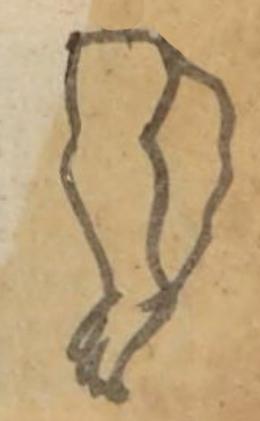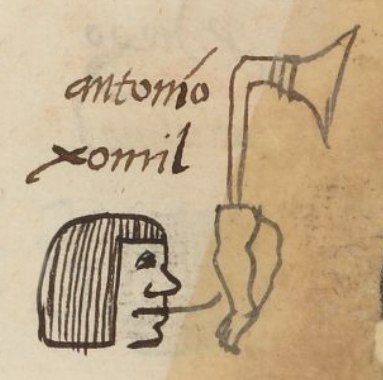Xomil (MH500r)
This black-line drawing of the simplex glyph for the personal name Xomil (here, attested as a man's name) shows two upright legs, one behind the other, and the front one turned slightly to the viewer's left. One foot (xo-) is especially visible, although small, compared to the legs. There is nothing obvious in this glyph to point to -mil component of the name. The contextualizing image for the person named Xomil shows an axe, which is an indicator of his occupation, probably as a woodcutter.
Stephanie Wood
Apparently, the suggestion of a foot (xo-) is meant to call to mind the name Xomil, which refers to an edible insect. It is somewhat surprising that no effort was made to draw a milli (an agricultural field), which could have provided a visual for the second syllable.
An association between babies and bugs is not unusual across cultures. There is an entire Reddit discussion about nicknames like "Bug," "Bugg," and "Cockroach." (See: https://www.reddit.com/r/thisisus/comments/9u1lqu/i_love_you_bug/.) Beyond that, many insects that are popular as personal or place names are for edible insects, which would not suggest any aversion to them.
Stephanie Wood
antonio
xomil
Antonio Xomil
Stephanie Wood
1560
Jeff Haskett-Wood
insects, insectos, comestibles, edible, nombres de hombres

xomil, a type of edible insect, https://nahuatl.wired-humanities.org/content/xomil
xo, foot, https://nahuatl.wired-humanities.org/content/xo
mil(li), agricultural parcel, https://nahuatl.wired-humanities.org/content/milli
El Jumil
Stephanie Wood
Matrícula de Huexotzinco, folio 500r, World Digital Library, https://www.loc.gov/resource/gdcwdl.wdl_15282/?sp=79&st=image
This manuscript is hosted by the Library of Congress and the World Digital Library; used here with the Creative Commons, “Attribution-NonCommercial-ShareAlike 3.0 License” (CC-BY-NC-SAq 3.0).






